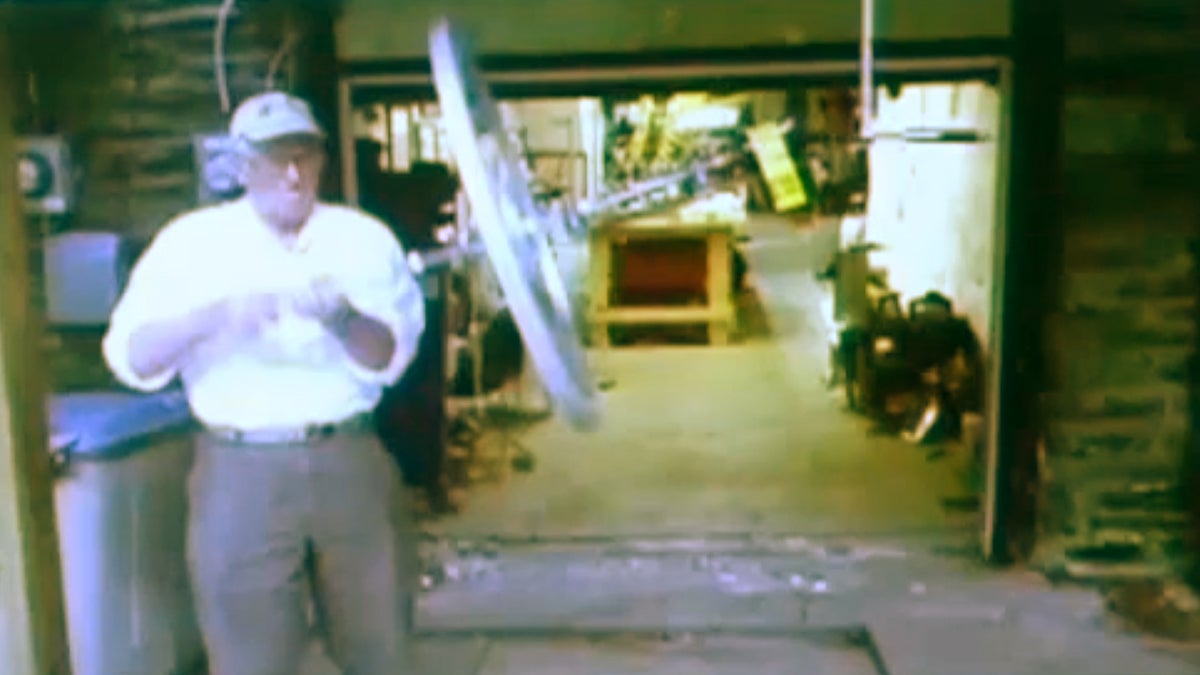Gyroscopes, a local inventor and physics on the fringe
Listen
Scientific discovery is often ferried along by passionate people working tirelessly to prove something out. It happens in corporate research and development, on university lab benches and, sometimes, in basement workshops.
In his Northwest Philadelphia home, the latter is where you’ll find one Fran McCabe.
“I am a somewhat screwball inventor,” McCabe says. “But I’m trying to give up the screwball side of things.”
He says he’s onto something.
A maker
McCabe, 76, studied at Drexel University in the 1950s, but dropped out. He then flew planes in the Navy. Then he started a fire control business in the late ’60s.
“You would pressurize the non-fire zones and you would depressurize the fire zones,” explains McCabe. “I patented all the equipment it takes to do that kind of stuff.”
McCabe has been successful in business, but he’ll be the first to tell you: he’s no established scientist. No Ph.D., no master’s, no nothing.
Still, his work on airfoils helped start a small wind turbine company in Bucks County a few years ago. In all, he has more than 100 patents to his name.
But his passion is gyroscopes.
He thinks they can be an energy game-changer.
Gyroscopes?
You’ve maybe played with gyroscopes as a kid. They rotate and spin around an axis and do things that seem kind of unreal.
Of course, they also have real-world applications. Gyroscopes are really good at keeping a steady orientation, so they’re mostly used for navigation — in everything from cruise ships to space shuttles.
But McCabe’s gyroscopes are all about power and motion.
His Mt. Airy basement is filled with devices, most of which use various configurations of gyroscopes to do stuff. He’s been working on his homemade machines for more than 30 years.
Some might be able to launch something really fast. Some make compressed air for powering things. Some are just silly.
“Now this is the world’s first, we think, gyro-powered balloon-inflating machine,” McCabe said at a recent presentation.
But he sees the most potential in what he calls a dynamo.
The dynamo
It’s basically a big metal disc, about three feet across, hanging kind of like a tire swing from the wooden patio above the back entrance to his workshop. The disc is mounted on an axle, which is attached to the wooden patio above. At the top is a small motor.
Once that motor gets the disc spinning, and a quick shove gets the axle rotating roughly parallel to the ground, McCabe says the dynamo puts out way more energy than he puts in.
“You could ultimately, you’re saying, power a house?” he’s asked.
“That’s what I’m trying to do,” McCabe says. “But this won’t do it because this is working to handle its own weight. What you gotta do is trick this thing out of handling its own weight and make it do work.”
He still has to figure that out, but here’s the kicker with McCabe’s devices so far: He says they can put out as much as a thousand times the energy you put in.
“A thousand to one,” McCabe told a meeting of fringe scientists at a presentation in Colorado over the summer. “I know this is a very audacious statement, but that’s the way it seems to work.”
Sounds cool, huh?
According to physics, it’s also entirely impossible.
Pseudoscience
“Science is a delicate balance between bold conjectures, often seemingly outrageous ones, and the hard-headed skepticism that tests it against the hard lessons of experience and experiment,” says Donald Simanek, emeritus professor of physics at Lock Haven University of Pennsylvania.
“In every mechanism that has ever been made, the energy is strictly conserved,” Simanek says. “You never get out more than you put in.”
Simanek would know. He’s the founder of the Museum of Unworkable Devices, a website of inventions that are too good to be true.
McCabe’s dynamo would qualify for inclusion.
Laws of physics
Unity is a law of physics where you can only ever get, at best, a 1-to-1 ratio of input-to-output.
McCabe’s dynamo is an “over-unity device,” which is basically another word for “perpetual motion machine.”
“Because you could use some of that excess energy and feed it into the input and you’d have a machine that’s producing energy without any external input at all,” Simanek says. “Wouldn’t that be great? But nature doesn’t work that way.”
McCabe knows his findings don’t jibe with established physics. He says, with gyroscopes, you get something totally different from the norm. They behave in different ways and aren’t yet fully understood.
Simanek, on the other hand, would say McCabe has made a profound mistake in his calculations — and that he’s just the latest in a long line of inventors captivated by the bogus idea of “free energy.”
Try, try again?
You might ask: Isn’t there value in trying for things that others say could never work?
Some people see it that way. From hand washing in hospitals to continental drift, plenty of stuff that was initially scoffed at was later accepted as fact.
There are whole societies of people doing peer-reviewed science on subjects far outside the mainstream.
Then again, there’s whole societies of “skeptics” (locally, they go by the acronym PhACT) who say such scientists and inventors should direct their energies toward, as one of them says, the “realm of the possible.”
“You have this intuition,” McCabe responds. “And people have it, it’s abundant, everybody has it. Some people use it, polish it off a little bit, but you intuit that there’s something better than what is out there. Basically, intuition takes you past knowledge.”
And that’s the point of contention, right? Whether there’s room for raw intuition in science.
Most would say no. But a few will always keep saying yes.
WHYY is your source for fact-based, in-depth journalism and information. As a nonprofit organization, we rely on financial support from readers like you. Please give today.

